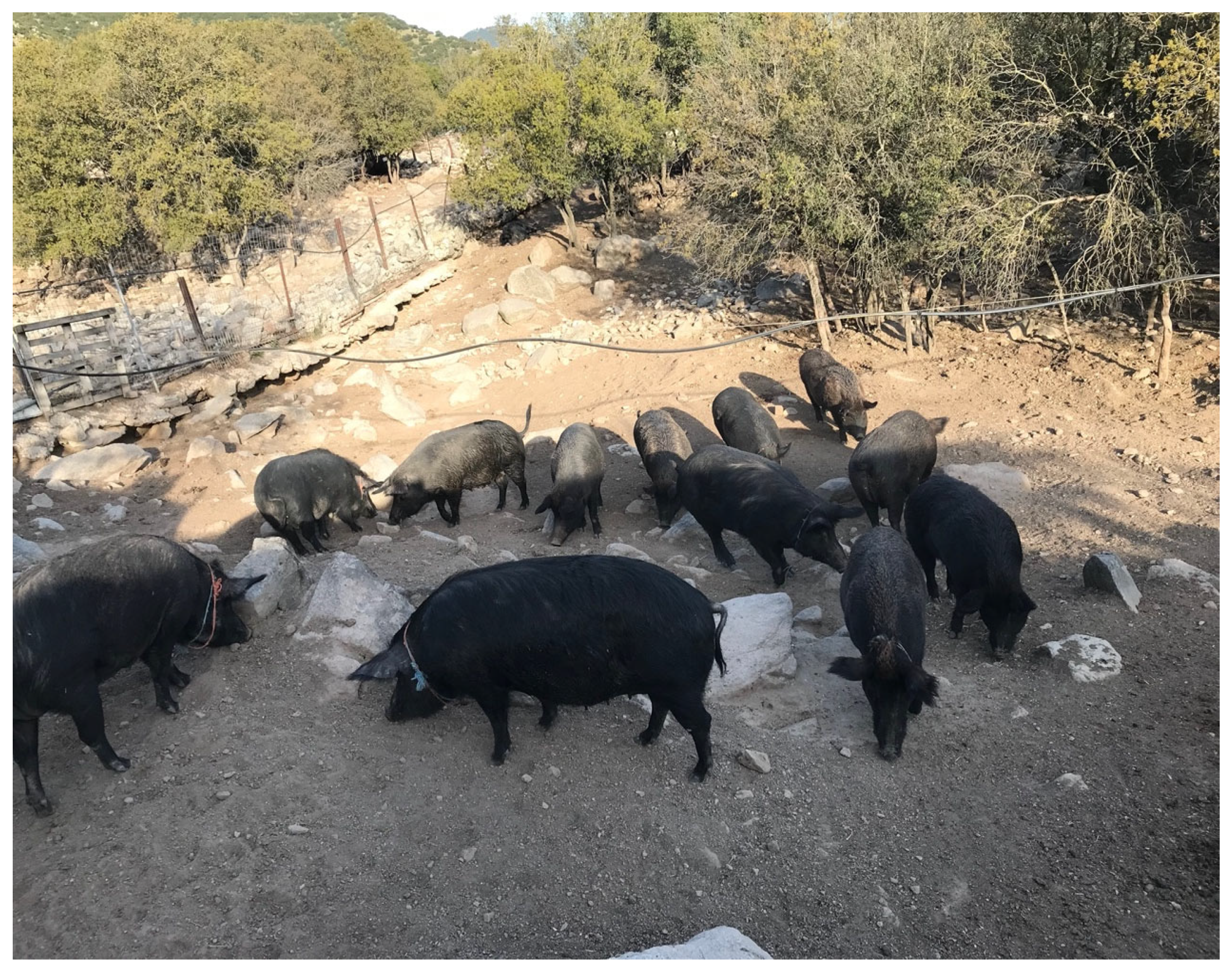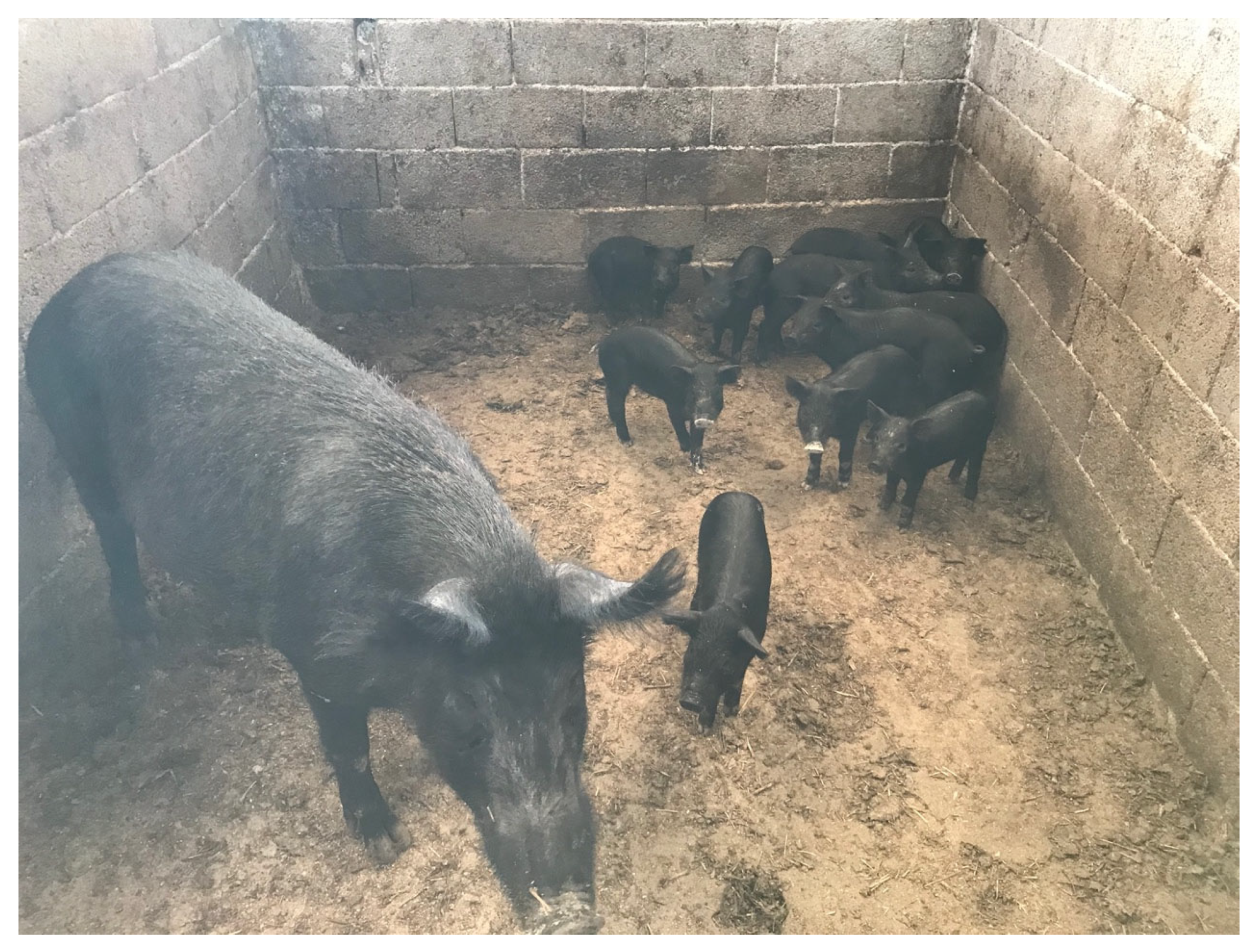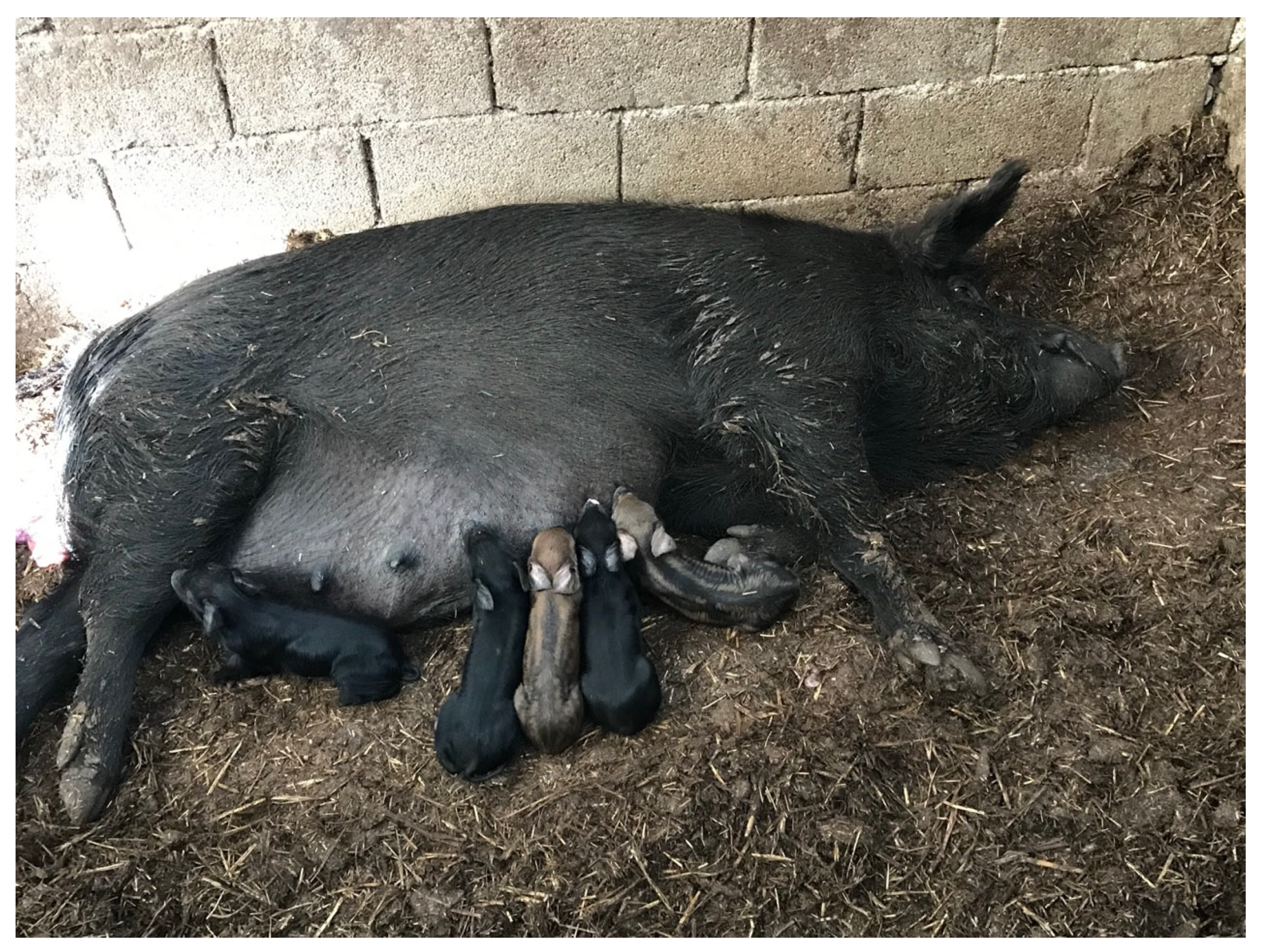You're using an outdated browser. Please upgrade to a modern browser for the best experience.

Submitted Successfully!
Thank you for your contribution! You can also upload a video entry or images related to this topic.
For video creation, please contact our Academic Video Service.
| Version | Summary | Created by | Modification | Content Size | Created at | Operation |
|---|---|---|---|---|---|---|
| 1 | Vasileios Papatsiros | -- | 2187 | 2023-11-17 10:36:19 | | | |
| 2 | Rita Xu | Meta information modification | 2187 | 2023-11-17 10:41:45 | | |
Video Upload Options
We provide professional Academic Video Service to translate complex research into visually appealing presentations. Would you like to try it?
Cite
If you have any further questions, please contact Encyclopedia Editorial Office.
Papakonstantinou, G.I.; Arsenakis, I.; Pourlis, A.; Papatsiros, V.G. Organic Pig Population in Greece. Encyclopedia. Available online: https://encyclopedia.pub/entry/51746 (accessed on 26 December 2025).
Papakonstantinou GI, Arsenakis I, Pourlis A, Papatsiros VG. Organic Pig Population in Greece. Encyclopedia. Available at: https://encyclopedia.pub/entry/51746. Accessed December 26, 2025.
Papakonstantinou, Georgios I., Ioannis Arsenakis, Aris Pourlis, Vasileios G. Papatsiros. "Organic Pig Population in Greece" Encyclopedia, https://encyclopedia.pub/entry/51746 (accessed December 26, 2025).
Papakonstantinou, G.I., Arsenakis, I., Pourlis, A., & Papatsiros, V.G. (2023, November 17). Organic Pig Population in Greece. In Encyclopedia. https://encyclopedia.pub/entry/51746
Papakonstantinou, Georgios I., et al. "Organic Pig Population in Greece." Encyclopedia. Web. 17 November, 2023.
Copy Citation
Information on the production, development and health status of organic pig farming in Greece and the potential prospects for sustainability and future development. Among the pig breeds reared on organic farms, the indigenous Greek Black Pig is the most common.
organic
farming
Greece
1. Introduction
The livestock sector plays a key role in the sustainability of rural economies and ecosystems and is characterized by significant environmental impacts. Due to the increasing global demand for products of animal origin, there is a need to develop modern livestock production systems that are consistent with current trends in food security and sustainability. Organic farming is proposed as an alternative production system to intensive farming and its negative ecological, social and economic consequences [1][2]. Organic agriculture is a production system based on ecological methods, biodiversity and natural sources adapted to local conditions, while intensive agriculture requires the use of methods that may be responsible for various negative impacts [2].
In Mediterranean regions where extensive agriculture is not prevalent, livestock production is the main source of income. The agricultural sector remains crucial to the rural economy, providing many employment opportunities and stabilizing the rural population. Therefore, it is crucial to protect and improve livestock production [3][4]. Different livestock systems have characteristics related to the cultural development of rural areas as they are crucial for the preservation of cultural heritage, including breeds, landscapes and habitats of high ecological value [5]. These characteristics are also associated with the economic development of rural areas. In addition, organic livestock production is characterized by significant environmental benefits, as it is based on environmentally friendly production systems such as extensive, free-range, pasture-based and/or organic livestock production [6].
In the last three decades, organic farming has been increasing annually in European Union (EU) countries, but there are differences between countries. In 2015, the total number of organically raised pigs was 0.978 million animals, with Denmark, France and Germany as the main organic pig producers. However, organic pig farming accounts for less than 1% of the total pig sector in the EU. In 2017, the proportion of organic farming was higher for ruminants (about 5% of the cattle herd and 6% of the sheep and goat herds) than for poultry and pigs (3% and less than 1%, respectively). Organic farming for cattle, sheep and goats is less expensive than poultry and pig farming, which is based on more expensive grain feeding, due to extensive grass feeding [6][7].
2. The Organic Pig Population in Greece
Organic production has gradually become a new agricultural sector in Greece. In 2002, national projects for the development of the organic pig sector were launched, mainly in the rural areas of western, central and northern Greece [7]. However, measures are needed to exploit its competitive advantages and expand this sector to a feasible scale [8]. In Greece, the total organic pig population was only 1288 in 2002, while it increased to 175,000 organic pigs in 2007. However, since 2008, the organic pig population has decreased significantly, mainly due to the reduction in funding for national projects triggered by the Greek economic crisis. Combined with the increase in feed costs and insufficient investment in reproduction management, modernization and equipment/barns, the decline in the Greek organic pig population has been significant [7].
European organic pig farms are based on three main production systems, including raising pigs (a) primarily indoors with access to limited outdoor space (e.g., in Austria and Germany), (b) outdoors year-round with access to temporary housing or permanent buildings (e.g., in Denmark, Italy and the United Kingdom) and (c) a combination of indoor and outdoor space during different production phases or seasons (e.g., in France and Sweden). In organic pig production, piglets may not be weaned before 40 days of age. In Greece, organic pig production includes systems where farrowing takes place mainly indoors, but the sow and her piglets have access to the outdoors at least until weaning (after 40–45 days). Fattening pigs spend most of their lives outdoors year-round but usually have access to permanent basic facilities for feed and water supply.
EU Council regulations (EC-1804/1999 and EC-834/2007) describe the rules for the appropriate risk assessment measures and include the concept of the production of processed feeds and criteria concerning products and substances used (e.g., non-organic feed materials and feed additives) in feed production [7][8][9][10][11]. For example, the main feed requirements for organic pigs are:
- (a)
- (b)
- (c)
- (d)
- (e)
-
feed containing minerals, trace elements, vitamins or provitamins shall be of natural origin. If these substances are not available, chemically well-defined analogous substances may be permitted for use in organic swine production. Some premixes and supplementary feeds contain prohibited substances and are therefore not permitted [9][10][11].
The following principles must be observed when using veterinary medicinal products in organic swine production:
- (a)
- (b)
-
antibiotics, coccidiostats, hormones, drugs, growth promoters and any other substances intended to stimulate growth or production shall not be used in animal nutrition. Hormones, however, may be administered to individual animals as therapeutic veterinary treatment. The use of veterinary vaccines is permitted when a disease has been identified as present in a specific area where the production unit is located [9][10][11].
- (c)
-
If the use of phytogenic and homeopathic remedies proves ineffective or is not appropriate to prevent the suffering or distress to the animal, chemical synthetic allopathic veterinary drugs or antibiotics may be used under the responsibility of a veterinarian. When veterinary drugs are used, the type of drug and the details of the corresponding records of the veterinarian (diagnosis, dose and withdrawal period of pharmacological substances, duration of treatment, method of administration) must be clearly indicated [9][10][11].
The Organic Farming Control and Certification System is managed by the Directorate of Organic Farming of the Greek Ministry of Rural Development and Food (HMRD) as the regulatory body, and by the Greek Agricultural Organization “ELGO-DIMITRA” (formerly AGROCERT—Organization for the Certification and Supervision of Agricultural Products), together with approved private inspection bodies. ELGO-DIMITRA is responsible for the implementation of the national policy objectives related to quality assurance and control in livestock and agriculture, based on (a) the assessment, approval and supervision of private certification bodies accredited by the Hellenic Accreditation System (ESYD) and (b) the elaboration and certification of the optional national AGRO standards (AGRO Standards, etc.) (https://www.elgo.gr) (accessed on 22 March 2023).
Greek organic pig farms keep either breeding wild pigs (Sus scrofa scrofa); or indigenous pig breeds (Greek Black Pig, Sus scrofa domestica); or hybrids from breeding boars and Greek Black pig with breeding wild pigs; or conventional pig breeds. The indigenous pig breed (Greek Black Pig, also called Greek Pig) is an autochthonous breed raised in Greece, and it is the most common indigenous breed in Greek organic pig farms (Figure 1 and Figure 2). The breed is widely used because of the well-known high quality of its meat and meat products (e.g., sausages and traditionally cured products). Nowadays, the total population is about 3000 animals, mainly kept in central and northern Greece [12]. However, the population of the Greek Black Pig remains small compared to the market demand [13]. Nevertheless, this ancient breed has specific characteristics that can be of great advantage in the implementation of breeding programmes to ensure the long-term survival of this breed [13]. In particular, they exhibit a high degree of genetic variability and adaptability; able to survive in different and harsh environmental conditions of free-range farming [14].

Figure 1. A breeding herd of indigenous Greek Black Pigs.

Figure 2. A farrowing sow (indigenous Greek Black Pig) and suckling piglets.
The native Greek Black Pig is an ancient inhabitant of the Mediterranean. In Greece, the breeding of the Greek Black Pig was the main component of extensive free-range farming until 1960. Thus, it was the only domesticated pig [7]. According to Greek mythology, the traces of this breed in the Greek territory date back to 9000 BC. In the years of Homer, it was the breed kept by Evmaios, the mythical swineherd of Odysseus, which fed on the Greek landscapes until a few decades ago. However, the earliest scientific traces of this breed in the Greek territory date back to 5500 BC, when bones of the native Greek Black Pig were found in Sitagrous, Drama [15]. The coat colour of the breed is diverse, as it shows great variations. Black is the predominant colour, but some animals are blackish brown, brown with white grooves, as well as black with white spots. Generally, Greek Black Pigs live in the wild, including oak woodlands. Female Greek Black pigs are characterised by seasonal reproductive activity and two farrowings per year (mean litter size of 8.48 ± 1.94 piglets) [14]. Most organic herds use natural methods of reproduction. However, artificial insemination is allowed, but the administration of hormones to synchronize oestrus or promote growth is prohibited in organic farming. Artificial insemination is the preferred reproductive method in swine production because it reduces the likelihood of breeding sows/chicks with infertile boars. Organic pigs reach sexual maturity relatively late. Therefore, they are weaned at 8 months of age, when their average body weight (BW) is 80–90 kg. The average weight of weaned piglets is estimated to be about 7.69 ± 0.69 kg, and finishing pigs are usually slaughtered at 240–300 days of age, reaching a carcass weight of about 60 kg [14]. In general, the carcass of the Greek Black Pig can provide excellent quality meat and especially cured meat products with excellent organoleptic characteristics. Therefore, Greek consumers distinguish the Greek Black Pig from all other pig breeds raised in the country. Disease resistance and a high degree of adaptation to climatic changes make the Greek Black Pig an ideal breed for rural areas with inhospitable environmental conditions [13].
One of the main problems of Greek organic pig farming is that breeding animals usually come from non-breeding farms and farmers use unprofessional breeding strategies, including crossbreeding with common breeds from commercial pig farms [13]. Nowadays, the differentiation of Greek breeds is based on phenotypic traits (i.e., coat colour, ear shape, etc.), which poses a great risk not only for the subjective criteria but also for the crossing of breeding animals with common breeds from commercial pig farms (e.g., Duroc) [16]. Crossbreeding between feral pigs and free-ranging pigs or Greek Black Pigs is a common practice in many wild pig farms in Greece [7] (Figure 3). Greek researchers reported a remarkable hybridization with wild boars in the studied wild boar populations of organic farms in northern Greece, probably due to an implemented breeding strategy or uncontrolled reproduction with wild boars [16]. A recent study revealed high genetic variability in the Greek Black Pig breed, suggesting that frequent admixture with both wild pig populations and other conventional pig breeds has occurred [12]. Therefore, any attempt to control and ensure the breeding of a particular native or wild population is done through phenotypic (morphological) characteristics (e.g., coat colour, ear shape, etc.). This fact poses great risks, firstly due to the subjective criteria and secondly because many farmers cross their herds with other improved (domesticated) breeds, which does not make it easy to certify and classify the bred animals as a pure breed or population [16]. For this reason, the establishment of a well-designed plan to maintain the genetic integrity of the Greek Black Pig breed is crucial for its survival and the increase of the overall population.

Figure 3. Crossbreed suckling piglets from an indigenous Greek black sow bred with a farmed wild boar. Personal archive of Prof. Vasileios Papatsiros.
In Greece, there are no nucleus farms producing replacement gilts for organic farms. Many organic pig farms purchase gilts from conventional farms. According to the current legislation on organic pig farming, all animals must come from organic farms, except in cases necessary for the renewal of the herd, so a 20% share of conventional pigs is allowed (breeding animals from non-breeding farms). A breeding sow or gilts purchased from a conventional farm may give birth to organic piglets if the sow or gilts are kept organically during the last trimester of gestation. However, compliance issues have been raised because many organic pig farmers do not follow the recommended rules [7][16][17]. In addition, gilts purchased from conventional farms are difficult to adapt to outdoor conditions. Producing gilts on free-range farms could provide breeding stock that is optimally adapted to outdoor conditions. In general, local breeds are suitable for organic pig production, especially when crossed with conventional white boar breeds to improve carcass quality (e.g., leanness) [17]. This could be an option for the development of organic pig production in Greece since the total population of local pig breeds remains low.
References
- Aertsens, J.; Mondelaers, K.; Van Huylenbroeck, G. Differences in retail strategies on the emerging organic market. Br. Food J. 2009, 111, 138–154.
- Brčić-Stipčević, V.; Petljak, K. Research on Organic Food Purchase in Croatia. Tržište 2011, 23, 189–207.
- Boyazoglu, J.; Hatziminaoglou, I.; Morand-Fehr, P. The role of the goat in society: Past, present and perspectives for the future. Small Rumin. Res. 2005, 60, 13–23.
- De Rancourt, M.; Fois, N.; Lavín, M.P.; Tchakérian, E.; Vallerand, F. Mediterranean sheep and goats production: An uncertain future. Small Rumin. Res. 2006, 62, 167–179.
- Gellrich, M.; Baur, P.; Koch, B.; Zimmermann, N.E. Agricultural land abandonment and natural forest re-growth in the Swiss mountain: A spatially explicit economic analysis. Agric. Ecosyst. Environ. 2007, 118, 93–108.
- Akamati, K.; Laliotis, G.P.; Bizelis, I. Comparative Assessment of Greenhouse Gas Emissions in Pig Farming Using Tier Inventories. Environments 2022, 9, 59.
- Papatsiros, V.G.; Boutsini, S.; Ntousi, D.; Stougiou, D.; Mintza, D.; Bisias, A. Detection and zoonotic potential of Trichinella spp. from free-range pig farming in Greece. Foodborne Pathog. Dis. 2012, 19, 536–540.
- Labros, S.; Grigoriou, I.; Anyfantis, I.; Nousia, M.; Koukoumpliakos, I.; Kiriakou, D. Organic Production In Greece—Challenges And Lessons Learned. Eur. Sci. J. 2014, 10, 73–85.
- Council Regulation No. 1804/1999 of Supplementing Regulation No. 2092/1991/EEC on Organic Production of Agricultural Products and Indications Referring Thereto on Agricultural Products and Foodstuffs to Include Livestock Production. Available online: https://eur-lex.europa.eu/legal-content/EN/TXT/PDF/?uri=CELEX:01999R1804-19990824 (accessed on 8 August 2023).
- Council Regulation No. 834/2007/EC of 28 June 2007 for Organic Production Labelling of Organic Products, Repealing Regulation No. 2092/1991/EEC. Available online: http://eur-lex.europa.eu/LexUriServ/LexUriServ.do?uri=OJ:L:2007:189:0001:0023:EN:PDF (accessed on 8 August 2023).
- Zoiopoulos, P.; Hadjigeorgiou, I. Critical Overview on Organic Legislation for Animal Production: Towards Conventionalization of the System? Sustainability 2013, 5, 3077–3094.
- Ribani, A.; Taurisano, V.; Karatosidi, D.; Schiavo, G.; Bovo, S.; Bertolini, F.; Fontanesi, L. Signatures of Admixture and Genetic Uniqueness in the Autochthonous Greek Black Pig Breed Deduced from Gene Polymorphisms Affecting Domestication-Derived Traits. Animals 2023, 13, 1763.
- Michailidou, S.; Kalivas, A.; Ganopoulos, I.; Stea, E.; Michailidis, G.; Tsaftaris, A.; Argiriou, A. A multi-farm assessment of Greek black pig genetic diversity using microsatellite molecular markers. Genet. Mol. Res. 2014, 13, 2752–2765.
- Laliotis, G.P.; Marantidis, A.; Avdi, M. Association of BF, RBP4, and ESR2 Genotypes with Litter Size in an Autochthonous Pig Population. Anim. Biotechnol. 2017, 28, 138–143.
- Antikas, T.G. Pigs in Greece: From Boar (ing) Myths to Pig Epitaphs. In Proceedings of the International Conference―Pigs and Humans, Durham, UK, 26–29 September 2003.
- Laliotis, G.P.; Avdi, M. Evidence of genetic hybridization of the wild boar and the indigenous black pig in northern Greece. Biotechnol. Anim. Husb. 2018, 34, 149–158.
- Leenhouwers, J.; Merks, J. Suitability of traditional and conventional pig breeds in organic and low-input production systems in Europe: Survey results and a review of literature. Anim. Gen. Resour. 2013, 53, 169–184.
More
Information
Subjects:
Veterinary Sciences
Contributors
MDPI registered users' name will be linked to their SciProfiles pages. To register with us, please refer to https://encyclopedia.pub/register
:
View Times:
582
Revisions:
2 times
(View History)
Update Date:
17 Nov 2023
Notice
You are not a member of the advisory board for this topic. If you want to update advisory board member profile, please contact office@encyclopedia.pub.
OK
Confirm
Only members of the Encyclopedia advisory board for this topic are allowed to note entries. Would you like to become an advisory board member of the Encyclopedia?
Yes
No
${ textCharacter }/${ maxCharacter }
Submit
Cancel
Back
Comments
${ item }
|
More
No more~
There is no comment~
${ textCharacter }/${ maxCharacter }
Submit
Cancel
${ selectedItem.replyTextCharacter }/${ selectedItem.replyMaxCharacter }
Submit
Cancel
Confirm
Are you sure to Delete?
Yes
No




